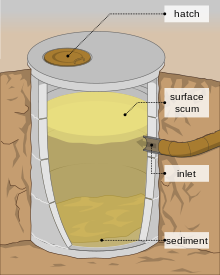
Cesspit, cesspool and soak pit in some contexts are terms with various meanings: they are used to describe either an underground holding tank (sealed at the bottom) or a soak pit (not sealed at the bottom).[1] A cesspit can be used for the temporary collection and storage of feces, excreta, or fecal sludge as part of an on-site sanitation system and has some similarities with septic tanks or with soak pits. Traditionally, it was a deep cylindrical chamber dug into the ground, having approximate dimensions of 1 metre (3') diameter and 2–3 metres (6' to 10') depth. Its appearance was similar to that of a hand-dug water well.
The pit can be lined with bricks or concrete, covered with a slab, and needs to be emptied frequently when in use as an underground holding tank.[1] In other cases (if soil and groundwater conditions allow), it is not constructed watertight, to allow liquid to leach out (similar to a pit latrine or to a soak pit).
- ^ a b Tilley, E.; Ulrich, L.; Lüthi, C.; Reymond, Ph.; Zurbrügg, C. (2014). Compendium of Sanitation Systems and Technologies (2nd Revised ed.). Swiss Federal Institute of Aquatic Science and Technology (Eawag), Duebendorf, Switzerland. ISBN 978-3-906484-57-0.